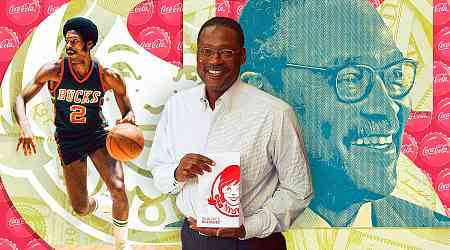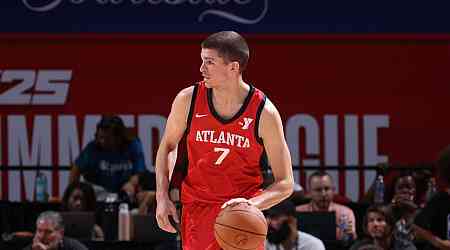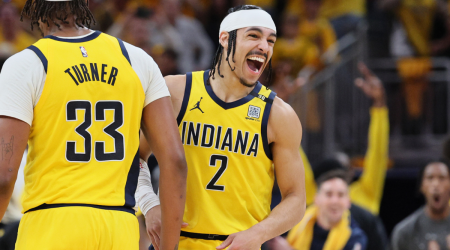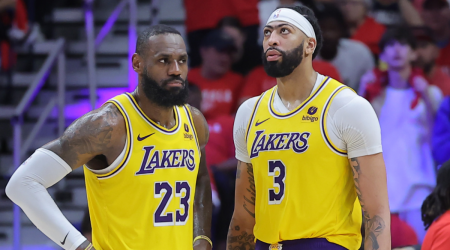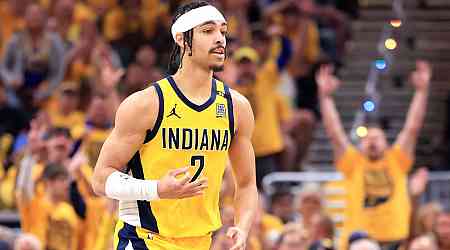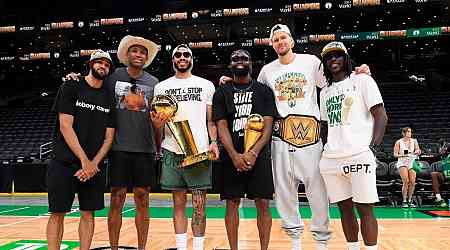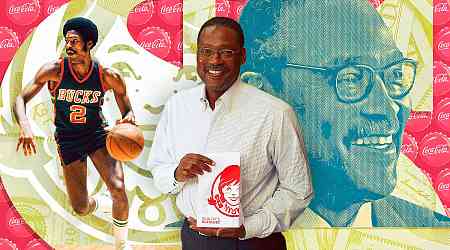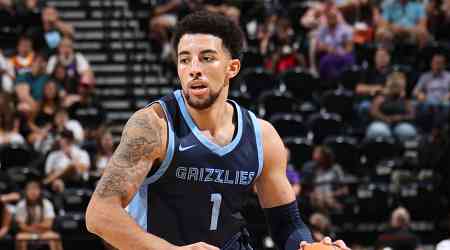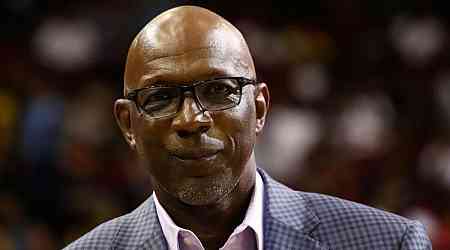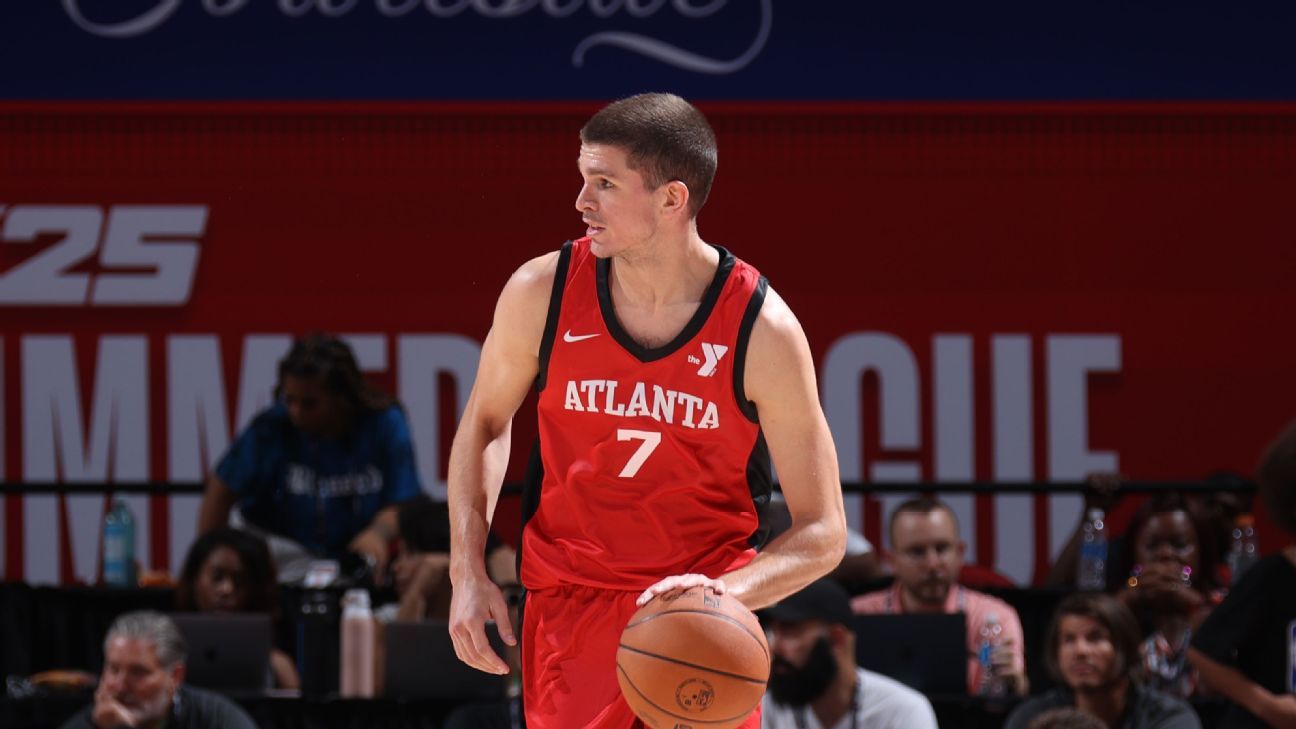ONE DAY IN 1988, a woman approached the counter of a Wendy's fast food restaurant in South Milwaukee. "Here's your food," a tall man said, pushing a tray toward her. Puzzled, she peered up at the man, whom she recognized as an NBA player, then down at her food, then back at him. Later that week, the woman called into a local radio station.
As the woman spoke, Junior Bridgeman was driving to his downtown Milwaukee office.
"I just think it's a shame," Bridgeman recalled her saying.
"What are you talking about?" one of the hosts responded.
"I stopped at a Wendy's the other day," she continued, "and these NBA basketball players make all this money and, when their career is over, they still have to work at Wendy's."
Bridgeman looked at his car's speakers. "Oh my god," he told himself. He was the ex-player who had served her. She was talking about him.
Bridgeman, who played for the Milwaukee Bucks from 1975 to 1984, laughed. What the woman didn't know was that the recently retired Bridgeman wasn't merely working at that Wendy's location. The 6-foot-5 former wing owned it -- and others across the city.
But Bridgeman understood her point. Salaries for players then weren't that high by today's standards. In Bridgeman's 12-season career, which included a stint with the LA Clippers, he made about $2.95 million and never more than $350,000 in a season.
After his career, he built a fast-food empire that, at its peak, totaled more than 450 restaurants nationwide. He became a Coca-Cola bottling distributor with territory across three states and into Canada. He bought Ebony and Jet magazines. His estimated net worth soared to nearly $600 million, behind just Michael Jordan, Magic Johnson and LeBron James, among NBA players.
But unlike those household names, Bridgeman was never an NBA star; his post-NBA fortune came without rich endorsement deals or the ability to cash in on global fame.
He averaged 13.6 points, 3.5 rebounds and 2.4 assists in 25 minutes per game over his career, during which he established himself as one of the game's best sixth men. Bridgeman was an NBA everyman who made out well -- very well.
But, over time, Bridgeman's success became an outlier, an exception to the trend of pro athletes going broke because of money-hungry family and friends, costly post-career medical care, frivolous spending, shady investments, crooked financial managers, or any of the other myriad reasons.
Bridgeman has long tried to help. Since the early 1990s, he has spoken formally and informally to rookies and veterans, to NBA and college teams, sharing the lessons he has learned over 40 years in the business world about financial responsibility. Lessons that helped this NBA role player build a nine-figure, international empire.
And with the NBA on the brink of a new $76.4 billion media rights deal, one that will increase the salary cap 10% per year for the foreseeable future and eventually produce the first $100 million player in the league, Bridgeman believes financial literacy -- a subject the league and NBPA have long tried to teach -- is at its most paramount.
"What I'm scared and concerned about now," the 70-year-old said on a recent afternoon from Louisville, Kentucky, where he has lived since the late 1980s, "is you start to get that feeling that I've got so much money that I can't really blow it all.
"That's the first step," Bridgeman told ESPN, "in blowing it all."
GROWING UP IN the blue-collar community of East Chicago, Indiana, Bridgeman envied his peers in elementary school who were boy scouts.
They would wear their uniforms, and he imagined his own. One day after school, there was a sign-up event to join the program, and Bridgeman, his mother and his older brother sat through the presentation. When it was over, the officials said membership cost $1.25. His mother stayed silent, but Bridgeman walked home from school knowing he couldn't join because his family just didn't have the money.
Bridgeman's father spent 40 years working at a local steel mill; before his shift, he would clean the floor of a tavern, and afterward, clean windows at a department store. Sometimes, Bridgeman and his siblings helped.
In high school, Bridgeman spent summers working odd jobs, making about $20 to $40 per week -- money he tried to stretch throughout the school year.
He started playing basketball in the fourth grade, eventually starring on the 1971 Washington High School Senators' 29-0 state championship team, considered one of the greatest in Indiana history. Nearby Louisville offered a scholarship, and he received $15 each month for laundry, which he also tried to stretch. He worked summers at a farm equipment manufacturer, a steel-cutting company and during the midnight-to-7 a.m. shift at a Ford truck plant a couple times a week.
Bridgeman became an All-American, reached the 1975 Final Four and in 1988 was inducted into the school's athletics Hall of Fame. The Lakers drafted him eighth overall in 1975, then traded him to Milwaukee as part of a blockbuster deal for Bucks star Kareem Abdul-Jabbar.
Upon joining the league, Bridgeman said he didn't receive any formal financial advice or guidance from the team, league or the NBPA. In his first season, he received a salary of roughly $140,000 in two payments, the first in September and the other in March. After taxes and agent fees were taken out, that first paycheck amounted to about $55,000, he said.
He spent $7,500 on his first new car, a cinnamon-colored 1975 Ford Thunderbird, then rented an apartment, bought furniture and sent money home to his parents. Then, his attorney called, telling Bridgeman to make sure he set money aside to pay taxes; Bridgeman hadn't considered the idea. And he wasn't sure how he was going to stretch his paycheck until the next one arrived five months away. He asked his attorney about setting up a monthly budget.
"Well, just don't spend too much," his attorney replied.
Nobody on the team spent much as it was -- no fancy watches or jewelry. "You didn't have that kind of money," Quinn Buckner, a Bucks teammate, told ESPN. During one of his early seasons, Bridgeman recalled that the collective payroll for all 12 players, as well as three coaches was $1.8 million.
"He was as buttoned up as you could be and still be an athlete," Buckner said. "You think athletes run around, stay out late and do all that. Junior didn't do any of that."
Bridgeman carried no illusions, nor did his teammates, that the NBA would set them up for life. "The numbers just didn't work," ex-Bucks guard Sidney Moncrief, one of Bridgeman's teammates, told ESPN "And I think every player in their mind, although you really think you can play forever, the reality is -- you can't."
They knew NBA careers were quite short -- the average spanning about five years -- and one bad injury could cut them even shorter. "There was always a sense of urgency about creating more money," Moncrief said.
Basketball was their purpose, Buckner said, but they knew they'd need to find another -- and before their career ended. They'd sit in the sauna after practice and talk about it. Bridgeman wondered what else there might be. And he knew the clock was ticking.
ONE SATURDAY MORNING in 1978, Bridgeman walked into a McDonald's in Milwaukee. It was alive with customers, with energy. Bridgeman headed toward the back to say hello to Wayne Embry, then the Bucks' general manager but also a McDonald's franchisee, with locations across the city. Seeing Embry there, an epiphany emerged. So many players went to work for someone after their NBA careers ended, but Embry, a former player himself, owned his own business. Instead of working for someone, people were working for him.
Bridgeman had no idea how the fast-food business worked, but Embry's path intrigued him. The energy in the restaurant intrigued him. He started to wonder if he could do the same, knowing he'd need to set enough money aside to break into the business. He specifically hoped to set aside $1,000,000 in savings during his career -- a goal that came about after he became close with Bucks owner Jim Fitzgerald and Bucks minority owner Dan Neviaser.
Opportunity arrived that same year, when Fitzgerald asked players if they wanted to invest in a recently purchased cable television operation in the area. The price: $150,000, to be paid over a few years.
Bridgeman signed on. About five years later, Fitzgerald sold the company, and Bridgeman received a check for $700,000, marking the first financial win of his life.
"What I'm scared and concerned about now is you start to get that feeling that I've got so much money that I can't really blow it all. That's the first step in blowing it all."Junior Bridgeman, on rising NBA salaries and financial literacy
Bridgeman remained close with Fitzgerald and Neviaser. One of the main principles they emphasized: Whatever business you're involved in, learn it from the ground up. Another: Make sure the right people are in the right positions -- people you can trust. Bridgeman viewed those lessons through the lens of basketball. To have success in the game, he knew, you had to study it, you needed the right set of teammates. You needed chemistry. You needed a good culture.
Their principles made sense, forming a foundation that Bridgeman carried for decades.
But Bridgeman also knew money could present a problem for players. The issue consistently bubbled up during meetings with the NBPA, where Bridgeman had joined as a player representative during his second season, in 1976-77.
"Guys were losing money," Bridgeman said.
Maybe they were mismanaging money, or someone was mismanaging it for them. But players kept leaving the league with empty pockets. By 1981, Bridgeman says now, the NBPA leadership collectively agreed to take action: They would contact managers at investment firms to see if they would speak to players about financial literacy.
The response was quick, with nearly two dozen managers agreeing, which Bridgeman and other NBPA officials knew was partly because those managers saw an opportunity to sign players up as clients.
During one meeting in Los Angeles, a manager stood on an amphitheater-like stage and spoke for two hours to players. "I don't think anybody had any idea what he said," Bridgeman recalled. He was too specific, too advanced. "It was our fault." Bridgeman said. "We probably should've educated the presenter on their audience. They just came in thinking they are presenting high-net-worth individuals that knew a lot about what they were talking about."
The effort fizzled out, but it marked the first time in Bridgeman's career that he tried to help teach players about financial literacy.
In 1984, Bridgeman, 30, was still playing for the Bucks when a banking friend from Chicago gave him a tip: Clients of his were interested in opening a Wendy's on the city's South Side. Maybe he could partner up? Bridgeman agreed to become a passive investor. Two years later, Bridgeman made an offer to buy the restaurant in full but was turned down, and he later sold his interest. It was his first foray into the restaurant business.
When he retired from the NBA in 1987, the Bucks offered him an assistant general manager position. He declined, finding himself just as interested in business as he had been in basketball. Instead, he opened a Wendy's franchise in Brooklyn with ex-NBA forward Paul Silas, a good friend. Together, they initially invested about $100,000. It failed, and they lost about $150,000 altogether, Bridgeman said.
Silas returned to the NBA to resume a coaching career, but Bridgeman was determined. The mistake he had made, Bridgeman came to realize, was that they didn't know anything about the restaurant business -- the same lesson that Fitzgerald and Neviaser had preached years earlier. So he joined a Wendy's training program, spending months visiting other franchises, learning what worked and what didn't.
The next year, in 1988, Bridgemen invested what remained from his NBA savings -- about $750,000 -- to buy five Wendy's locations in Milwaukee. He would still spend time with his current and former teammates in the Milwaukee area. Then, Bridgeman would say, "Well, I have to go to the restaurant." And he'd be off.
"He'd be working in the restaurant like he was an hourly worker," Moncrief said. "I witnessed that. I was thinking, what the heck is he doing in there flipping burgers, washing dishes, and he had those work pants on. But he understood the value of learning thoroughly what you're investing in -- very, very hands on." Moncrief watched how Bridgeman would write out checks, a small task that could have easily been delegated. "He wanted to know where every check was going," Moncrief said. "When money went out, he wanted to feel that."
The margins were thin. At times, Bridgeman had to bail someone out of jail or help someone whose apartment caught fire. They turned over the staff at some locations several times before finding the right staffers for the right roles.
When he bought the stores, they were averaging about $600,000 in annual revenue, he said. Two years later, all five returned $2 million each.
BRIDGEMAN EXPANDED AGGRESSIVELY. He bought 16 more Wendy's in Milwaukee, then added more in Madison, then expanded out of state -- in Louisville, Nashville, Tennessee, and across Florida. He began adding Chili's restaurants to his portfolio. He had moved to Louisville and spent days communicating with district managers who ran different groups of his restaurants.
In the early 1990s, the NBPA, which considers Bridgeman to be one of its most successful former players in the business world, asked him to create a program to introduce interested players to the restaurant business. He designed one that lasted four days. Players would learn finances, the day-to-day operations, with some even working the grill. But few were interested. The program lasted for about five years. Roughly 30 players went through it; just five stayed in the business.
One decade after retiring, Bridgeman realized that he had earned in his post-NBA career what he had made while playing -- nearly $3 million. But as he worked to forge his own success beyond the game, Bridgeman too often saw other NBA peers becoming ensnared in financial calamity. He had winced a decade earlier, in 1987, when Abdul-Jabbar sued his former business manager to recover $59 million for allegedly mishandled tax returns and "improper" investments. As the years passed, Bridgeman saw more instances with the same recurring themes.
Former NBA center Vin Baker lost more than $100 million in career earnings and later became a Starbucks barista. Former NBA guard Kenny Anderson made $63 million and filed for bankruptcy the year he retired. Former NBA MVP Allen Iverson made more than $200 million but said during a 2012 divorce proceeding that he didn't have enough to afford a cheeseburger. Former All-Star Latrell Sprewell lost more than $97 million.
A financial manager who has worked with NBA players for two decades told ESPN the same problems persist today.
From 2004 through 2019, according to a 2021 report from the global accounting and consulting firm EY, professional athletes alleged almost $600 million in fraud-related loss -- and research showed that as endorsement revenue and salaries rose, so, too, did cases of fraud. Just last year, a former Morgan Stanley investment adviser was charged with defrauding players -- Jrue Holiday, Chandler Parsons and Courtney Lee -- out of $5 million.
"The only difference now is that the money is bigger," the manager said. "People are still reckless. They just have a longer runway."
As salaries have grown, Moncrief said he understands that players today might believe they're impervious to ruin. "We felt we were invincible, too," Moncrief said.
Then, in the late 1990s, the NBA called with a simple ask: share your story with rookies about money and life after the NBA. Bridgeman quickly said yes.
FOR SEVERAL YEARS, beginning in in the late 1990s, Bridgeman stood before nearly 60 rookies in a hotel conference room as part of the league's Rookie Transition Program, which the league founded in 1986 as part of its first efforts to help teach basics about financial literacy: budgeting, saving, taxes.
Bridgeman shared what he'd heard from former Bucks head coach Don Nelson: Their job was to play as hard as they can and make as much money as they can. He offered guardrails: Know the business well and put someone in charge who you trust, who is qualified. "More guys have lost money investing in deals with their second cousin on their mother's side running it than anything else," Bridgeman said. Doing something like that, he said, was a "blueprint for failure."
He said that during a player's career, doors would open, phone calls would be returned. So if a player were on the road in Detroit and wanted to become involved in the automobile industry, they would have the chance to reach out to the head of one of the automotive giants. Opportunities were everywhere. All they had to do was ask.
He also shared that players didn't have to provide for everyone around them. They didn't have to support a full entourage, even if they saw others doing so. He said the people around players often try to justify their place in a player's life, but that the players needed to take charge for themselves.
"I wish I had a nickel for every nickel I loaned out when I was playing," Johnson said. "These are not family. These are just guys I played with, guys I grew up with. As soon as they're aware of the money you're making, it's a field day in terms of them hitting you up. That was one of the hardest things I had to learn: how to say no."
Bridgeman said they would have to be prepared to lose money.
"I'm not smarter than anybody in this room or better than any of you guys were at anything," he'd say, "but you've got to be willing to work at it and learn it."
As he stood before the rookies, Bridgeman knew many didn't listen -- and perhaps understandably so. He could try to relate to them, but he was born in 1953, nearly twice their age, and so much had changed.
ON A RECENT morning in Las Vegas during the NBA summer league, with the temperature building toward a blistering 115 degrees, league and NBPA officials found air-conditioned refuge inside a futuristic event space called StarBase, located just off the Strip. Inside, officials were setting up for the league's Business Mentorship Program, which pairs players with industry experts for a 10-week mentorship program geared toward that player's business interests.
Now in its fifth year, that program is one of several from the league and NBPA that prioritize financial literacy. Sitting on a couch, Jamila Wideman, who serves as the NBA's senior vice president of player development, watched the flurry of activity.
Today, Wideman told ESPN, players have access to financial auditing and forensic accounting firms that can examine a player's portfolio and alert them to suspicious activity. They have access to databases that will note if a financial adviser has any red flags with FINRA or is CPA-verified. They have access to videos that offer advice, including from former players, such as Shaquille O'Neal.
Financial literacy remains a key component through the Rookie Transition Program, which continues to this day, and through Team Awareness Meetings, with each team holding two over the course of the season that feature NBA officials and NBPA representatives.
As part of those programs, former players such as Eduardo Nájera, Eddy Curry and Antoine Walker have spoken to rookies and current players.
On one end of the spectrum, there is Nájera, a scout for the Dallas Mavericks, a part owner of the Dallas Sidekicks of the Major Arena Soccer League and vice president of business development for the Mezas Capital Group, an investment firm in Texas.
On the other end are Curry, the No. 4 overall pick in 2001, who ended up in debt despite nearly $70 million in career earnings, and Walker, a former NBA All-Star who blew through more than $100 million. Walker and Curry focus more on what not to do, multiple sources said.
Horror stories have long been part of the financial curriculum shared with rookies and veteran players, according to one source close to such efforts over the past decade. One popular tale, the source added, involved two former NBA MVPs -- Tim Duncan and Kevin Garnett.
In 2015, Duncan sued his former financial adviser, whom he met in his rookie year and who allegedly conned him out of nearly $25 million. In a statement then, Duncan said he prided himself on "not being the stereotypical dumb athlete that can easily be taken advantage of." He said he built a team of people "to make sure I wouldn't be another athlete sitting in this exact predicament at some point." But he said he trusted his financial adviser too much. It was embarrassing, Duncan said.
Garnett sat in the back of one hearing in a San Antonio federal court. He had attended to support the financial adviser, whom he also worked with, investing millions. But Garnett's expression changed as he listened to testimony. A reporter for the San Antonio Express-News witnessed Duncan talking to Garnett during a break. The two players, once fierce rivals, shook hands. In 2018, Garnett filed a lawsuit against his accountant and the accountant's firm, saying they enabled the financial adviser to steal $77 million from him.
"We told that story until the cows came home," one source said.
NOW, MOST OF Bridgeman's money is tied up in trusts for his family, which leads him to a new lesson -- one that he is especially passionate about for modern players: building generational wealth. The contracts now are large enough -- not just for the stars but across the league -- for players to stretch their earnings into future generations of their family.
"Now you're talking about real wealth," Bridgeman said.
Wideman said they are broaching the subject with young players. "We certainly try to create some literacy around all the instruments that are available to them," she said.
Even now, Bridgeman serves as an informal adviser and mentor to players and teams across the league. He is still credited by the NBPA with one of the mightiest financial leaps in NBPA history -- one with a direct link to the eye-popping contracts that are now routine.
In 1987, during his tenure as NBPA president, the union filed a federal lawsuit -- what became known as the "Bridgeman antitrust suit" -- against the NBA and its owners. Several players, including Bridgeman, alleged that the league's salary cap, draft and right of first refusal on free agency were restrictive, violating antitrust laws. Team owners sought to avoid litigation, and a new CBA was agreed upon in 1988, leading to several changes, among them unrestricted free agency.
One month into this year's free agency, the NBA has already surpassed $5 billion in one season, the highest in league history. Players are more flush with cash today than his generation could have ever imagined. Bridgeman just hopes they can avoid the time-tested pitfalls that have created a stigma around professional athletes.
"Money can disappear," he said. "Whether it's $80,000 or $80 million, it can still disappear on you."
Today, Bridgeman lives near downtown Louisville with his wife Doris, their marriage in its 48th year. They have raised three children -- Eden, Justin and Ryan -- who are all involved in various aspects of his businesses. On a daily basis, he is more involved with the Coca-Cola bottling operation -- his territories contribute about 50 million to 60 million bottles and cans annually -- than restaurants. Those that remain -- about 175 locations around the country -- are overseen by one of his sons. He has admittedly slowed down, the fire to succeed having dimmed with age. When asked to look back, he paused.
"It was fun," Bridgeman said. "People said, 'How could it be fun?' It was. It was fun -- like playing basketball."




















